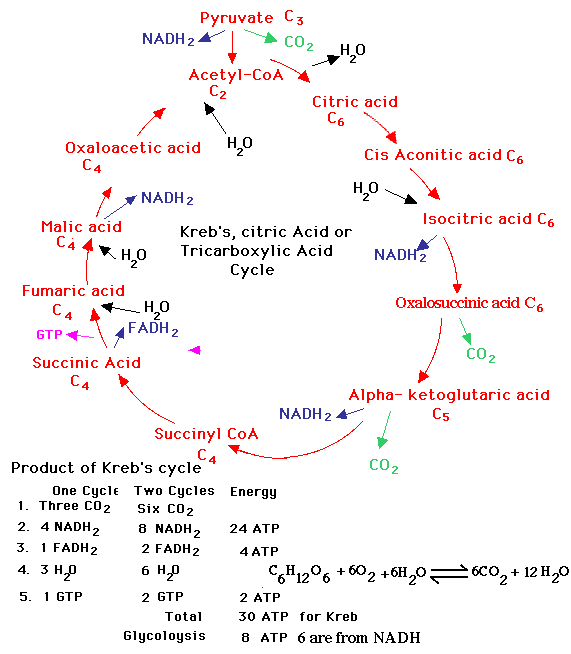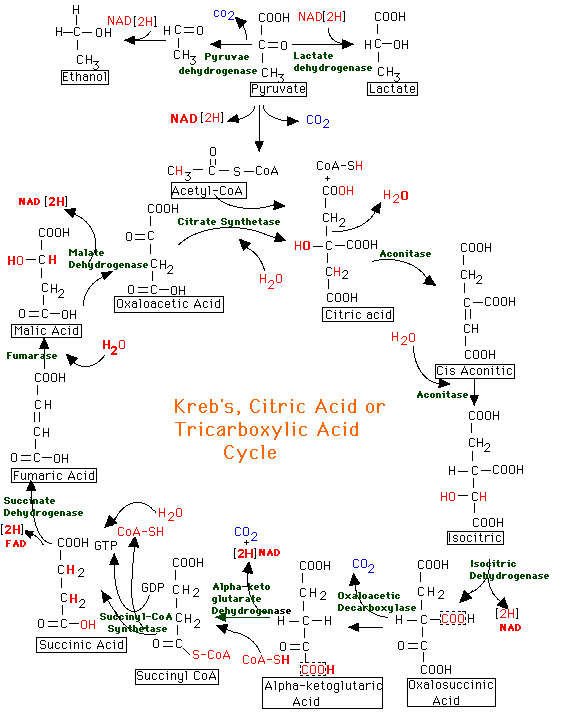|
What is Glycolysis? Where does glycolysis occur? What is/are the reactants/reagents necessary for glycolysis? What is/are the product of glycolysis? Does this process need or use oxygen? How much energy does glycolysis produce? What is the advantage of producing energy from glycolysis? What is the Pyruvate Dehydrogenase (PDH) Complex? What are the reactants for the PDH cycle? What is the product of the PDH cycle? What is the advantage of using this process? What is the Citrus Acid Cycle? Where does the Citrus Acid Cycle occur? Does the TCA Cycle need or use oxygen? What is the reactant of the TCA cycle? What is the product of the TCA cycle? What is the advantage of the TCA cycle? Why is glycolysis important? Who uses glycolysis? What happens to the products of glycolysis? What does the term "glycolysis" mean? How many stages does glycolysis have? What happens in the process of glycolysis? What is ATP? Is alanine necessary for nutrition? What is alanine? Where is alanine found? How is alanine used? What do I need to know? What is its function? What is the overall reaction? What are the processes involved? Where does the energy come from? What's the point of all the phosporylation? Glycolysis is a series of chemical reactions, that are a part of the cellular respiratory cycle of aerobic and anaerobic type. The entire glycolysis process takes place in the cytoplasm of eukaryotic cells. The entire process of glycolysis is a sequence of ten reactions, with many intermediate compounds being created. Every one of the glycolysis steps involves the creation of intermediate compounds. There are two important types of Glycolysis pathways. One is the Embden-Meyerhof pathway, while the other one is the Entner-Doudoroff pathway. The glycolysis reaction which I talk about here is the Embden-Meyerhof pathway. Glycolysis products and reactants are a part of many metabolic processes. Anaerobic glycolysis takes a six carbon sugar (glucose), splits it into two molecules of three carbon sugar (glyceradehyde) and then rearranges the atoms (to lactate). The rearrangement of atoms provides energy to make ATP which is the principle energy 'currency' in the cell. The starting point for glycolysis is normally glucose although other monosacharides may be brought into the pathway. The end product, in anaerobic conditions, depends on the organism. In higher organisms the end product is lactate whereas in some microorganisms (for example brewers yeast) it is ethanol and carbon dioxide. 1. What is Glycolysis? Glycolysis is the sequence of reactions that converts glucose into pyruvate with the concomitant production of a relatively small amount of ATP. Glycolysis can be carried out anerobically (in the absence of oxygen) and is thus an especially important pathway for organisms that can ferment sugars. For example, glycolysis is the pathway utilized by yeast to produce the alcohol found in beer. Glycolysis also serves as a source of raw materials for the synthesis of other compounds. For example, 3 phosphoglycerate can be converted into serine, while pyruvate can be aerobically degraded by the Krebs or TCA cycle to produce much larger amounts of ATP. 2. Why do human/animal need glycolysis? Glycolysis is perhaps the first step in the __________ energy producing. 3. Where does glycolysis occur? Glycolysis occurs in the cytoplasm of the cell, and it must precede the Krebs Cycle. 4. What is/are the reactants/reagents necessary for glycolysis? Glycolysis of requires glucose to produce energy. 5. What is/are the product of glycolysis? Glycolysis produces a net amount of 2 ATP and 2NADH 6. Does this process need or use oxygen? _____________________. 7. How much energy does glycolysis produce? Glycosis produces 2ATP and 2 NADH which then goes into the Oxidative Phosphorylation cycle which then produces more ATP. 8. What is the advantage of producing energy from glycolysis? Glycolysis, is considered as the basis for all energy processes in the cell. Althoug it only produces low levels of ATP, normally called basal levels, this process also produces large quantities of NADH which when processed by the Oxidative Phosphorylation pathway can produce large amount of energy. Glycolysis can also be carried out throughout the cell, which gives it an advantage over the TCA and Oxidative phosphorylation cycles that occur in the mitochondria. Review of Pyruvate Dehydrogenase (PDH) Complex The fate of pyruvate depends on the cell energy charge. In cells or tissues with a high energy charge pyruvate is directed toward fatty acid synthesis, but when the energy charge is low pyruvate is preferentially oxidized to CO 2 and H 2 O in the TCA cycle, with generation of 15 equivalents of ATP per pyruvate. What is the Pyruvate Dehydrogenase (PDH) Complex ? The PDH Complex is a series of biological step that prepare the pyruvate produced in glycolysis to go into the TCA cycle. These processes chemically convert pyurvate to Acetyl-CoA that can then enter the TCA cycle. What are the reactants for the PDH cycle? Pyruvate from glycolysis What is the product of the PDH cycle? Acetyl-CoA What is the advantage of using this process? This process allow for the chemical conversion of pyruvate into Acetyl-Co A which can then be inserted into the TCA cycle for processing. Review of Citrus Acid Cycle 1.What is the Citrus Acid Cycle? Krebs cycle or the citric acid cycle or tricarboxylic acid cycle is the common pathway to completely oxidize fuel molecules that mostly is acetyl CoA, the product from the oxidative decarboxylation of pyruvate. It enters the cycle and passes ten steps of reactions that yield energy and CO(pyruvate to acetyl CoA). 2. Where does the Citrus Acid Cycle occur? The mitochondrial membrane Does the TCA Cycle need or use oxygen? Yes. The Citrus Acid Cycle does need oxygen. How much energy does the TCA cycle produce? Per turn of the TCA cycle 3 NADH, 1 FADH 2 , and 1ATP What is the reactant of the TCA cycle? Acetyl-CoA produced from the pyruvate from glycolysis and converted by the PDH complex. Citrate is also a reactant, which can come from OAA in the citrus acid cycle. What is the product of the TCA cycle? In fact since the TCA cycle feed backs into itself there is no net products. However, TCA cycle 3 NADH, 1 FADH 2 , and 1ATP are produced each turn. What is the advantage of the TCA cycle? The advantage of the TCA cycle is that it cycles that it can cycle which means that it can repeat for several times to accumulate several products which can be either used as direct energy or put into the oxidative phosphorylation pathway which can produce large amounts of energy. Citrus Acid Cycle Steps Step 1: Reaction: Acetyl CoA+Oxaloacetate to Citrate Enzyme: Citrate synthase Reaction type: Condensation Description: Acetyl CoA condenses with oxaloacetate first,to form citryl CoA. Then citryl CoA is hydrolyzed to citrate and CoA Step 2. Reaction: Citrate to cis-Aconitate Enzyme: Aconitase Reaction Type: Dehydration Description: Citrate is isomerized to isocitrate by this first dehydration and yields cis-aconitate as an intermediate. Step 3. Reaction: cis-Aconitate to Isocitrate Enzyme: Aconitase Reaction Type: Hydration Description: Hydration of cis-aconitate gives the interchange of H atom and OH group from the step 2. Step 4. Reaction: Isocitrate to alpha-Ketoglutarate Enzyme: Isocitrate dehydrogenase Reaction Type: Oxidative decarboxylation Description: Dehydrogenation of isocitrate occurs and yields oxalosuccinate as an intermediate.Then CO 2 leaves to have alpha-ketoglutarate.This reaction gives NADH. Step 5. Reaction: alpha-Ketoglutarate to Succinyl CoA Enzyme: alpha-Ketoglutarate dehydrogenase complex Reaction Type: Oxidative decarboxylation Description: This mechanism is almost as same as the reaction of the oxidative decarboxylation of pyruvate to acetyl CoA by pyruvate dehydrogenase complex. This reaction gives one NADH. Step 6. Reaction: Succinyl CoA to Succinate Enzyme: Succinyl CoA synthetase Reaction Type: Substrate-level phosphorylation Description: The thioester bond of succinyl and CoA is an energy rich bond. Thus only this step gives a high-energy phosphate compound,GTP from the couple reactions of the thioester bond cleavage and the phosphorylation of GDP. Step 7. Reaction: Succinyl CoA to Succinate Enzyme: Succinate dehydrogenase Reaction Type: Oxidation Description: The two hydrogens of succinate leave to an acceptor, FAD. Then this reaction yields fumarate and FADH 2 . Step 8. Reaction: Succinate to Fumarate Enzyme: Succinate dehydrogenase Reaction Type: Oxidation Description: The two hydrogens of succinate leave to an acceptor, FAD. Then this reaction yields fumarate and FADH 2 . Step 9. Reaction: Fumarate to Malate Enzyme: Fumerase Reaction Type: Not described. Description: Not described. Step 10. Reaction: Malate to Oxaloacetate Enzyme: Malate dehydrogenase Reaction Type: Oxidation Description: Malate is dehydrogenated to form oxaloacetate. The hydrogen acceptor is NAD. So this reaction yields NADH. Krebs Cycle Pictures and Summary -------------------------------------------------------------------------------- As the above diagram illustrates, this is truly a continuous cycle. Acetyl coenzyme A binds to the oxaloacetate in order to convert it to citrate. Water is released from the citrate and then regained in order to form isocitrate. NAD+ binds to isocitrate, leaves as NADH, and carbon dioxide is lost in order to form a-ketoglutarate. NAD+ binds to a-ketoglutarate, leaves as NADH, coenzyme A binds and carbon dioxide is lost in order to form succinyl CoA. Coenzyme A leaves in order to form succinate. FAD binds to succinate and leaves as FADH2 in order to form fumarate. Water binds to fumarate and forms malate. NAD binds to malate and leaves as NADH which creates a new oxaloacetate molecule ready to bind to another acetyl coenzyme A to start the process over again. 

|
| Cellular Respiration |
| Glycolysis |
| Comparison of Aerobic & Anaerobic Respiration http://www.livestrong.com/article/148550-comparison-of-aerobic-anaerobic-respiration/ |
|
What Is Aerobic Respiration? What Is the Role of Glucose in Aerobic Respiration? |
|
Comparison chart Aerobic Respiration Anaerobic Respiration |
|
What Is Anaerobic & Aerobic Respiration?
Is the Krebs Cycle Aerobic or Anaerobic? |
